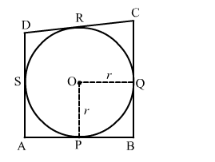In the given figure, a circle with centre O is inscribed in a quadrilateral ABCD such that, it touches sides BC, AB, AD and CD at points P, Q, R and S respectively. If AB = 29 cm, AD = 23 cm, ∠B = 90° and DS = 5 cm, then the radius of the circle (in cm) is

(a) 11 (b) 18 (c) 6 (d) 15 [CBSE 2013]
It is given that the sides BC, AB, AD and CD touches a circle with centre O at points P, Q, R and S, respectively.
AB = 29 cm, AD = 23 cm, ∠B = 90° and DS = 5 cm.
Now,
DR = DS = 5 cm (Lengths of tangents drawn from an external point to a circle are equal)
AR = AD − DR = 23 cm − 5 cm = 18 cm
∴ AQ = AR = 18 cm (Lengths of tangents drawn from an external point to a circle are equal)
BQ = AB − AQ = 29 cm − 18 cm = 11 cm
∴ BP = BQ = 11 cm (Lengths of tangents drawn from an external point to a circle are equal)
Now, AB is a tangent at Q and OQ is the radius through the point of contact Q.
$\therefore \angle \mathrm{OQB}=90^{\circ}$ (Tangent at any point of a circle is perpendicular to the radius through the point of contact)
BC is a tangent at P and OP is the radius through the point of contact P.
$\therefore \angle \mathrm{OPB}=90^{\circ} \quad$ (Tangent at any point of a circle is perpendicular to the radius through the point of contact)
$\angle \mathrm{B}=90^{\circ} \quad$ (Given)
Also, BP = BQ
So, OPBQ is a square.
∴ OP = OQ = BQ = 11 cm (Sides of square are equal)
Thus, the radius of the circle is 11 cm.
Hence, the correct answer is option A.
